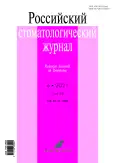Клиническая эффективность методики восстановления контактных поверхностей боковых зубов с учетом возрастных особенностей
- Авторы: Пермякова А.В.1, Николаев А.И.1, Монахова А.Н.1, Петрова Е.В.1
-
Учреждения:
- Смоленский государственный медицинский университет
- Выпуск: Том 25, № 6 (2021)
- Страницы: 539-547
- Раздел: Клинические исследования
- URL: https://journals.rcsi.science/1728-2802/article/view/109450
- DOI: https://doi.org/10.17816/1728-2802-2021-25-6-539-547
- ID: 109450
Цитировать
Аннотация
Актуальность. В настоящее время используемые в стоматологии методики эстетической реставрации боковых зубов композитными материалами предусматривают создание точечных контактных пунктов, что не соответствует возрастным особенностям зубов взрослых пациентов.
Цель — разработать и внедрить в стоматологическую практику методики формирования и позиционирования контактных площадок с учетом возрастных особенностей строения зубов.
Материал и методы. Оценено качество восстановления контактных поверхностей зубов и контактных пунктов (площадок) с учетом возрастных особенностей, в том числе 289 прямых композитных реставраций при дефектах 2-го класса по Блеку, выполненных в процессе лечения кариеса зубов у 178 пациентов в возрасте от 20 до 59 лет. Характеристики 162 композитных реставраций 2-го класса по Блеку, выполненных с восстановлением контактных площадок с применением контакт-формеров, сопоставляли с характеристиками 127 композитных реставраций 2-го класса по Блеку, проведенных с использованием традиционной методики восстановления.
Результаты. В исследуемых группах через 7 сут после лечения клиническим требованиям (4 балла) по критериям оценки качества восстановления контактных поверхностей зубов и контактных площадок полностью соответствовали 98,3±1,02% реставраций, через 12 мес — 92,5±2,07%, через 24 мес — 74,8±3,41% исследованных композитных реставраций зубов. В группах сравнения полностью соответствовали клиническим требованиям по данному показателю (4 балла) через 7 сут после лечения 16,3±3,28% реставраций (р <0,005), через 12 мес — 11,3±2,81% (р <0,005), через 24 мес — 9,8±2,64% (р <0,005).
Заключение. Клиническое применение разработанной методики формирования контактных площадок боковых зубов с учетом возрастных особенностей и с использованием контакт-адаптера оригинальной конструкции позволяет повысить качество восстановления контактных поверхностей зубов, контактных площадок, межзубных амбразур и анатомии межзубных промежутков в целом.
Полный текст
Открыть статью на сайте журналаОб авторах
Анастасия Владимировна Пермякова
Смоленский государственный медицинский университет
Email: perm_86@list.ru
ORCID iD: 0000-0003-4490-2041
ассистент кафедры
Россия, 214019, Смоленск, ул. Крупской, 28Александр Иванович Николаев
Смоленский государственный медицинский университет
Автор, ответственный за переписку.
Email: anicolaev@inbox.ru
ORCID iD: 0000-0002-1378-6538
д-р мед. наук, профессор
Россия, 214019, Смоленск, ул. Крупской, 28Анна Николаевна Монахова
Смоленский государственный медицинский университет
Email: antonova.a.n@mail.ru
ORCID iD: 0000-0003-1637-2733
ассистент кафедры
Россия, 214019, Смоленск, ул. Крупской, 28Елена Викторовна Петрова
Смоленский государственный медицинский университет
Email: elena-v-petrova@yandex.ru
ORCID iD: 0000-0002-1869-9409
канд мед. наук, доцент
Россия, 214019, Смоленск, ул. Крупской, 28Список литературы
- Sarig R., Vardimon A.D., Sussan C., et al. Pattern of maxillary and mandibular proximal enamel thickness at the contact area of the permanent dentition from first molar to first molar // American Journal of Orthodontics and Dentofacial Orthopedics. 2015. Vol. 147, N 4. P. 435–444. doi: 10.1016/j.ajodo.2014.11.026
- Практическая терапевтическая стоматология: учебное пособие: в 3 томах / под ред. А.И. Николаева, Л.М. Цепова. 10-е изд., перераб. и доп. Москва: МЕДпресс-информ, 2018. Т. 1.
- Coulehan J.L. The Medical Interview: Mastering Skills for Clinical Practice. 9th edition. California: Davis Company, 2005.
- Веденева Е.В., Гуревич К.Г., Вагнер В.Д., Фабрикант Е.Г. Связь клинической картины и качества жизни пациентов, обращающихся за эстетическим стоматологическим лечением // Стоматология для всех. 2009. № 4. С. 4–6.
- Chuang S.-F., Su K.-C., Wang C.-H., Chang C.-H. Morphological analysis of proximal contacts in class II direct restorations with 3D image reconstruction // Journal of Dentistry. 2011. Vol. 39, N 6. P. 448–456. doi: 10.1016/j.jdent.2011.04.001
- Loomans B.A.C., Opdam N.J.M., Roeters F.J.M., et al. Restoration techniques and marginal overhang in Class II composite resin restorations // Journal of Dentistry. 2009. Vol. 37, N 9. P. 712–717. doi: 10.1016/j.jdent.2009.05.025
- Wang Y., Song Y., Zhong Q., Xu C. Evaluation of influence factors on the width, length, and width to length ratio of the maxillary central incisor: A systematic review and meta-analysis // Journal of Esthetic and Restorative Dentistry. 2020. Vol. 33, N 2. P. 351–363. doi: 10.1111/jerd.12606
- Лясова А.О. Восстановление контактного пункта: путь к успеху // Бюллетень медицинских Интернет-конференций. 2017. Т. 7, № 10. С. 1510–1516.
- Практическая терапевтическая стоматология: учебное пособие: в 3 томах / под редакцией А.И. Николаева, Л.М. Цепова. 10-е изд., перераб. и доп. Москва: МЕДпресс-информ, 2021. Т. 2. С. 1008.
- Sfondouris T., Prestipino V. Chairside management of an open proximal contact on an implant-supported ceramic crown using direct composite resin // The Journal of Prosthetic Dentistry. 2019. Vol. 122, N 1. P. 1–4. doi: 10.1016/j.prosdent.2018.10.019
- Колодкина В.И., Арутюнов А.В. Морфологическая структура эмали, дентина зубов и композитных пломбировочных материалов in vitro // Российский стоматологический журнал. 2018. Т. 22, № 4. С.176–179.
- Николаев А.И. Гильмияров Э.М., Митронин А.В., Садовский В.В. Критерии оценки композитных реставраций зубов. Москва: МЕДпресс-информ, 2015.
Дополнительные файлы












